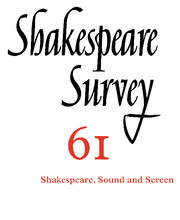Book contents
- Frontmatter
- Sarah Siddons, theatre voices and recorded memory
- Playing with Shakespeare’s play: Branagh’s Love’s Labour’s Lost
- Bottom and the gramophone: Media, class and comedy in Michael Hoffman’s A Midsummer Night's Dream
- Maurice Evans’s Richard II on Stage, Television and (Almost) Film
- Richard II on the Screen
- ‘Where Lies Your Text?’: Twelfth Night in American Sign Language Translation
- ‘This uncivil and unjust extent against thy peace’: Tim supple’s Twelfth Night, or what violence will
- ‘There’s no such thing’: nothing and nakedness in Polanski’s Macbeth
- Ghosts and mirrors: the gaze in film Hamlets
- ‘Ben, it’s a terrible thing to hate your mother’: mind control in Hamlet and The Manchurian Candidate
- Channelling the ghosts: the Wooster Group’s remediation of the 1964 Electronovision Hamlet
- Listening to Prospero’s Books
- Lend Me Your Ears: Sampling BBC Radio Shakespeare
- An Age of Kings and The ‘Normal American’
- Shakespeare and British Television
- A Local Habitation and a Name: Television and Shakespeare
- Paying attention in Shakespeare parody: from Tom Stoppard to YouTube
- Madagascan will: cinematic Shakespeares / transnational exchanges
- Still life? Anthropocentrism and the fly in Titus Andronicus and Volpone
- Riddling q1: Hamlet’s mill and the trickster
- ‘Speak, that I may see thee’: Shakespeare characters and common words
- Who do the people love?
- A Partial Theory of Original Practice
- Shakespeare Performances in England, 2007
- Professional Shakespeare productions in the British Isles, January–December 2006
- The Year's Contributions to Shakespearian Study 1 Critical studies
- 2 Shakespeare in performance
- 3a Editions and textual studies
- 3b Editions and textual studies: The RSC Complete Works
- Index to Volume 61
‘Where Lies Your Text?’: Twelfth Night in American Sign Language Translation
Published online by Cambridge University Press: 28 November 2008
- Frontmatter
- Sarah Siddons, theatre voices and recorded memory
- Playing with Shakespeare’s play: Branagh’s Love’s Labour’s Lost
- Bottom and the gramophone: Media, class and comedy in Michael Hoffman’s A Midsummer Night's Dream
- Maurice Evans’s Richard II on Stage, Television and (Almost) Film
- Richard II on the Screen
- ‘Where Lies Your Text?’: Twelfth Night in American Sign Language Translation
- ‘This uncivil and unjust extent against thy peace’: Tim supple’s Twelfth Night, or what violence will
- ‘There’s no such thing’: nothing and nakedness in Polanski’s Macbeth
- Ghosts and mirrors: the gaze in film Hamlets
- ‘Ben, it’s a terrible thing to hate your mother’: mind control in Hamlet and The Manchurian Candidate
- Channelling the ghosts: the Wooster Group’s remediation of the 1964 Electronovision Hamlet
- Listening to Prospero’s Books
- Lend Me Your Ears: Sampling BBC Radio Shakespeare
- An Age of Kings and The ‘Normal American’
- Shakespeare and British Television
- A Local Habitation and a Name: Television and Shakespeare
- Paying attention in Shakespeare parody: from Tom Stoppard to YouTube
- Madagascan will: cinematic Shakespeares / transnational exchanges
- Still life? Anthropocentrism and the fly in Titus Andronicus and Volpone
- Riddling q1: Hamlet’s mill and the trickster
- ‘Speak, that I may see thee’: Shakespeare characters and common words
- Who do the people love?
- A Partial Theory of Original Practice
- Shakespeare Performances in England, 2007
- Professional Shakespeare productions in the British Isles, January–December 2006
- The Year's Contributions to Shakespearian Study 1 Critical studies
- 2 Shakespeare in performance
- 3a Editions and textual studies
- 3b Editions and textual studies: The RSC Complete Works
- Index to Volume 61
Summary
In 1998 a team of Deaf and hearing artists set out to translate a full-length Shakespearian play into American Sign Language (ASL). Earlier attempts to translate Shakespeare, most notably those by the National Theater of the Deaf, had resulted in an adaptation of Hamlet, entitled Ophelia, as well as an hour-long version of Macbeth and a series of selected scenes and monologues from Shakespeare’s best-known works entitled Shakespeare Unmasked. Deaf schools and theatres around the country have produced dozens of Shakespeare’s plays over the years, but without any coherent methodology of translating his works into ASL and with few archives as examples. The aim of the ASL Shakespeare Project experiment was twofold. First, to translate one play, Twelfth Night, by means of a systematic and intellectually rigorous model, using digital technology to record the translation, and further to use the translation for a professional production of the play that was to open in Philadelphia almost two years after the translation process began. The second goal of the ASL Shakespeare Project was to disseminate the play itself as well as information about the process on a website completely accessible to Deaf students in both ASL and English. The result is www.aslshakespeare.com, the first bilingual and bicultural website on Shakespeare on the internet, and a full-length production of Twelfth Night (on DVD) performed in American Sign Language with simultaneous English voice-over and optional captioning. Translating one of Shakespeare’s most musical of plays into a visual and manual language has created a new Shakespearian artifact that fuses text with performance and provides a new perspective on both. This paper not only details the practical and theoretical implications underlying a translation of Shakespeare’s play into a visual/manual text, but also advocates for a re-envisioned definition of text itself.
- Type
- Chapter
- Information
- Shakespeare Survey , pp. 74 - 90Publisher: Cambridge University PressPrint publication year: 2008
- 2
- Cited by

